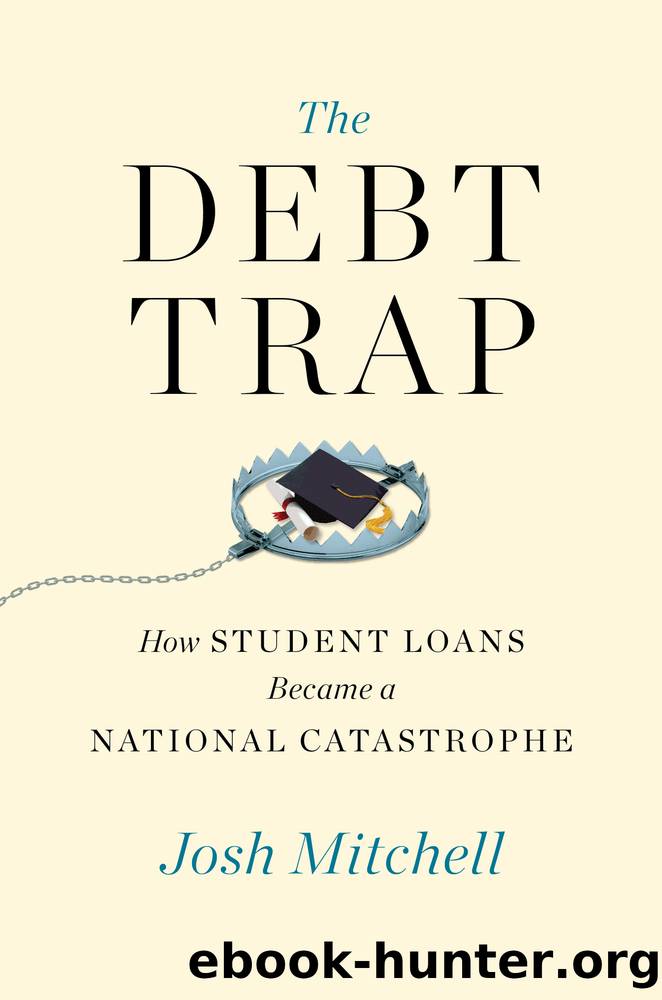The Debt Trap by Josh Mitchell

Author:Josh Mitchell [Mitchell, Josh]
Language: eng
Format: epub
Published: 2021-08-03T00:00:00+00:00
* * *
That spigot created both opportunity and hardship.
It enabled tens of millions of students to attend college. In Brandonâs case, it opened the doors to Howard, whose graduatesâmany of whom had grown up poorâtended to land high-paying jobs. But for Brandon, as well as for millions of other students, it also meant an unconscionably high debt burden.
Brandon continued to suffer from anxiety at Howard. His biggest source of worry was his student loan debt. He borrowed tens of thousands of dollars each yearâa mix of federal loans and private loans from Sallie Maeâwatching anxiously as the interest accrued.
Brandon hadnât realized when he matriculated that he would have to borrow so much. Students accepted early each year are more likely to get financial aid from schools. Students like Brandon who come in late in the admissions processâafter most of the schoolâs scholarship money has been doled outâare often left to pay most or all of the sticker price, despite their familiesâ lack of wealth. The only option for those students and their parents is to take on debt. They are in the worst position to repay debt but the ones most reliant on it.
While G.I. Bill funds and Pell Grants went toward Brandonâs tuition, much of Brandonâs debt went toward living expenses. Howard had overbooked its on-campus dorms and Brandon didnât get a room. Instead he rented an apartment for $980 a month in Prince Georgeâs County, Maryland, a half-hour drive from the school. He needed a car, and money for gas, parking, and maintenance.
Brandon could only pay for school if other family members took out debt as well. His great-grandmother co-signed his private loans from Sallie Mae. By the time he graduated in the summer of 2011, Brandon and his great-grandmother owed $148,000 in student debt, including interest. At the graduation ceremony, his great-grandmother was so proud she wept.
Brandon was part of one of the biggest graduating classes nationwide in historyâand also one of the most indebted. Higher education enrollmentâcollege and graduate schoolâhad just hit a peak of 21 million students. Two in three graduating seniors owed debtâ$27,000, on average. A small but fast-growing share, like Brandon, owed large balancesâ$50,000 and up.
Numerous factors collided to make this happen, some economic, some policy-related. One was a change the government made in the 1990s to begin charging interest on many student loans while borrowers were in school, driving up their balances by as much as 20 percent by graduation. Decades of lax regulation had enabled colleges to raise tuition to excessive levels. The recession also had wiped out household wealth. At a time when college was most important, it seemed, Americans were least able to pay for it. So they borrowed.
Brandon and his peers were graduating at one of the worst possible times. Even though the recession had ended two years earlier, unemployment remained exceptionally high. For most of 2011, it was above 9 percent, among the highest levels since the Great Depression. Many young college graduates lucky enough to find
Download
This site does not store any files on its server. We only index and link to content provided by other sites. Please contact the content providers to delete copyright contents if any and email us, we'll remove relevant links or contents immediately.
The Fifteen Biggest Lies about the Economy: And Everything Else the Right Doesn't Want You to Know about Taxes, Jobs, and Corporate America by Joshua Holland(1092)
The Economist (20210109) by calibre(898)
The World For Sale by Javier Blas(825)
Made in China by Anna Qu(815)
Philippines--Culture Smart! by Culture Smart!(673)
Boom and bust a global history of financial bubbles by Quinn William Turner John(658)
Mission Economy by Mariana Mazzucato(656)
Forex Trading All In One For Dummies by Mishra Mamta(645)
Big Money by Kenneth P. Vogel(628)
The Money Revolution by Anne Boden(621)
The Dictatorship of Woke Capital by Stephen R. Soukup(617)
The New Retirement Savings Time Bomb by Ed Slott(607)
Tax the Rich! by Morris Pearl(602)
Cross Winds: Adventure and Entrepreneurship in the Russian Far East by Myers Steven(592)
The Inflation Myth and the Wonderful World of Deflation by Mark Mobius(588)
Fundamentals of Finance by Mustafa Akan Arman Teksin Tevfik(564)
European Yearbook of International Economic Law 2017 by Marc Bungenberg Markus Krajewski Christian Tams Jörg Philipp Terhechte & Andreas R. Ziegler(559)
The Great Demographic Reversal by Charles Goodhart & Manoj Pradhan(555)
Business Recoded by Peter Fisk(546)
